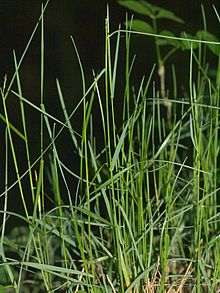Poa nemoralis
| Poa nemoralis | |
|---|---|

| |
| Scientific classification | |
| Kingdom: | Plantae |
| Clade: | Tracheophytes |
| Clade: | Angiosperms |
| Clade: | Monocots |
| Clade: | Commelinids |
| Order: | Poales |
| Family: | Poaceae |
| Subfamily: | Pooideae |
| Genus: | Poa |
| Species: | P. nemoralis |
| Binomial name | |
| Poa nemoralis | |
| Synonyms[1] | |
List
| |
Poa nemoralis, the wood bluegrass, is a perennial plant in the family Poaceae. The late-growing grass is fairly nutritious for livestock, which feed on it in the autumn, and it is used as a lawn grass for shady situations.
Description
It forms loose tufts, and is of a more delicate, slender appearance than other meadow grasses. It is slightly creeping. The leaves are narrow, tapering to a point. The ligules are short (0.5 mm). The stem is slender, 30–60 cm (12–24 in) high. The panicle is slender, loose and branched. The spikelets are few and egg-shaped. They have one to five flowers. This grass is in flower from June to August in the Northern Hemisphere. It can produce asexual seeds by means of apomixis and can also reproduce vegetatively.[2]
Because of the characteristic lamina, similar to a stretched out arm, it is sometimes called "Wegweisergras" (signpost grass) in Germany.[3]
Distribution and habitat
Wood bluegrass is native to Europe, where its range extends from Portugal to Bulgaria, and Asia where its range extends from Iran to Japan. It has been introduced in Australia and New Zealand, and to North America where it has become naturalised in southeastern Canada and northeastern United States.[2] Shade tolerant, it is often found in forests and grows up to half a metre tall.[3] It is generally distributed in Britain in dry woods, thickets and shady hedge banks on well drained soils. In its invasive range in America, it sometimes grows in coniferous forests, where its presence is thought to increase the risk of fires, and on floodplains, the banks of rivers and lakes, and disturbed sites.[2] In the British Isles, it is found throughout the United Kingdom but at more scattered locations in Ireland, where it may have been introduced.[4]
Footnotes
- ^ "Poa nemoralis L." Plants of the World Online. Board of Trustees of the Royal Botanic Gardens, Kew. Archived from the original on 25 January 2020. Retrieved 12 October 2021.
- ^ a b c "Poa nemoralis (wood bluegrass)". Invasive Species Compendium. CABI. Archived from the original on 12 August 2020. Retrieved 8 March 2020.
- ^ a b Haeupler & Muer 2007: 672
- ^ "Poa nemoralis". Online Atlas of the British and Irish Flora. Archived from the original on 12 August 2020. Retrieved 8 March 2020.
References
- Pink, A. (2004). Gardening for the Million. Project Gutenberg Literary Archive Foundation.
- Haeupler, Henning & Muer, Thomas (2007): Bildatlas der Farn- und Blütenpflanzen Deutschlands. Ulmer Verlag ISBN 978-3-8001-4990-2 (in German)
- The Observers Book of Grasses, Sedges and Rushes. Frances Rose. pp. 46–47
- Grasses, Ferns, Mosses and Lichens. (1980) Phillips, Roger p64
